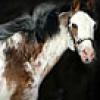Maximally expressed sabino or white?
Forums
Re: Maximally expressed sabino or white?
How interesting! Gee, people keep calling them maximally expressed sabinos. So, then...how did White Beauty come to have the dominant white gene?
ACC, I know you study TBs in addition to colors in other breeds. Are all white-colored TBs really 'white' rather than 'maximally expressed sabinos,' such as Clarence Stewart and Grand Espoir Blanc?
Thanks again!
Re: Maximally expressed sabino or white?
I suspect Ky Colonel was the culprit. When they did the dominant white study they found no less than 4 mutations of the same gene that resulted in dominant white. I'm not sure if they found more than one mutation in Thoroughbreds or not (I'm inclined to think no, that the separate mutations were separate breeds) but it's very possible that Ky Colonel was the first with the mutation. I know one of the mutations was also found in Arabians, and if it's the same mutation that's in Thoroughbreds I might be inclined to think that it was there all along but being suppressed somehow. I'd have to have more details on the actual study to have any confidence in any of those ideas though.
Horsegen and/or Nerd might be able to see a phenotypic difference between a true maximum sabino and a dominant white, but I don't have much confidence in myself for that. I do think it's possible that most total whites we see are actually dominant whites as opposed to max sabinos, but I have no way of backing that theory. Grand Espoir Blanc I feel a bit more confident about as I know the woman who actually foaled him out, and based on what she said I suspect he is/was(?) a white.
I DO know that Sato tested positive for dominant white which more than likely means Puchilingui was dominant white and thus any white offspring from that whole line is likely dominant white. They probably also have sabino, so some could be max sabinos, but it seems unlikely in comparison.
We do know Sabino1 works as an incomplete dominant, which means a homozygote will be 95%+ white, but Sabino1 has never been found in Thoroughbreds so it's a it of guesswork as to what all causes their white.
Re: Maximally expressed sabino or white?
I would look at the pedigree. If you have an extreme white pattern that inherits as an autosomal dominant (possibly homozygous lethal--we don't know yet), I would suspect dominant white. If it inherits as an incomplete dominant (incomplete in that heterozygous gives loudish sabino, homozygous gives all white), and is present in certain breeds (TWH, Missouri Foxtrotters, other American breeds... I think UC Davis has a list) then suspect SB-1. But there are other things that can cause white which we lump under the term 'sabino' that we do not yet understand, so when we say 'maximum sabino' we are only describing what the horse looks like, not what genes it might have that make it look that way.
So yes, I agree with ACC that the major white TB families are actually dominant white. Personally, I suspect that the mutations have arisen recently and independently, once for each family.
You might find the following papers on dominant white and SB-1 interesting:
Haase et al. Allelic heterogeneity at the equine KIT locus in dominant white (W) horses. PLOS GENETICS 3:2101-2108, 2007
Brooks S.A. and Bailey E. Exon skipping in the KIT gene causes a Sabino spotting pattern in horses. Mammalian Genome 16:893-902, 2005
Re: Maximally expressed sabino or white?
Thanks so much for the thoughts! :) I very much appreciate them.
When The White Fox (out of Patchen Beauty) was born he had a few red hairs up in his foretop...so would that be an incomplete penetration of the chestnut gene? (don't skewer me for my ignorance, ha ha) I think those red hairs disappeared by the time he was a few months old.
And here's a simple question for which I'm guessing there's no simple answer: What causes a mutation? Just a scrambling of genetic signals for no apparent reason?
Grand Espoir Blanc looked white white white, with a few small black spots on his pink skin. It's so neat that you know the woman who foaled him, acc! I envy her. It must have been "What the heck?" (or similar) :shock:
Re: Maximally expressed sabino or white?
Oh, and one more question: For a horse like Allamystique, who's got a bunch of black- and red-looking spots throughout his coat, around his eyes, nose, etc..... would he also probably be a dominant white? He's by Airdrie Apache, who's the leading TB sire of white horses.
A website describes Allamystique as "a maximum expressed sabino over a bay base coat, (bay and black sparkles showing from underneath the white hair, scattered throughout his body)...":
http://www.barbaralivingston.com/galler…" onclick="window.open(this.href);return false;
Re: Maximally expressed sabino or white?
[quote="Gander"]Thanks so much for the thoughts! :) I very much appreciate them.
When The White Fox (out of Patchen Beauty) was born he had a few red hairs up in his foretop...so would that be an incomplete penetration of the chestnut gene? (don't skewer me for my ignorance, ha ha) I think those red hairs disappeared by the time he was a few months old.
And here's a simple question for which I'm guessing there's no simple answer: What causes a mutation? Just a scrambling of genetic signals for no apparent reason?
Grand Espoir Blanc looked white white white, with a few small black spots on his pink skin. It's so neat that you know the woman who foaled him, acc! I envy her. It must have been "What the heck?" (or similar) :shock:[/quote]
Actually the chestnut medicine hat (so to speak) would be due to incomplete penetrance of the sabino or dominant white gene, in layman's terms. The reason it disappeared is that these horses tend to roan out, HEAVILY. The white just overtook the red. Patchen Prince started with a hat too, but by the time I saw him early in his two year old year there was no sign of it at all.
I think you pretty much hit the nail on the head with the mutation thing. That's layman's terms obviously and I couldn't help you with technical terms. Basically mutation is an aid to survival. Wild animals must be able to adapt or they can not survive and thus nature built in a system by which they change every so often. Now every change is not necessarily more helpful to their survival and thus die out rather quickly (aka HyPP would likely not have survived in the wild), those that are helpful continue on. The rate that these mutations occur is called the "mutation equilibrium" I believe and if I'm not mistaken is different in every species. I also think some genes mutate more readily than others. Dominant white woudl fall into that category IMO.
Grand Espoir Blanc was definitely the talk of the barn when he was foaled. You might get an idea what they thought of him if you heard his then barn name. :rofl Unfortunately it is not acceptable for repeat here. :laugh1 And yes, she said many times if she had been sitting on the edge of a building she'd have fallen off when she pulled him out. He was definitely a shock. There weren't many white Thoroughbreds at that time.
Re: Maximally expressed sabino or white?
Oh and I think Allamystique *looks* more like a max. sabino to me, but based on what we know of dominant white (that it can present reasonably minimally and thus horses that have color left should not be discounted) it very well could be.
FWIW I agree with Nerd that the mutations are recent (relatively speaking) and separate for each family.
Oh, btw, there is a family of totally white horses in Japan that I 100% believe are dominant white based on their production. Sunday Silence is involved in that somehow too. I forget how and I lost all the information when the other board crashed. I'll have to see if I can find my backups.





Re: Maximally expressed sabino or white?
I think she is one of the Dominant White line.